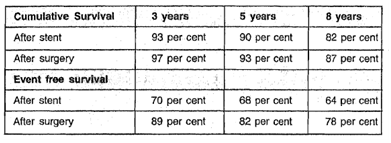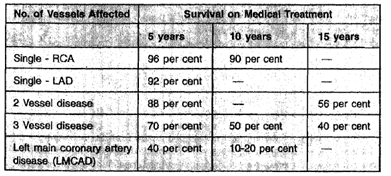Long-term Follow-up Results : To evaluate the long-term results of surgery, one has to take into consideration the natural history, results of medical treatment and that of PTCA. The main factors to be considered are: (1) number of vessels affected and the site of obstruction, (2) LV function, (3) severity of reversible ischnemia, and (4) previous history of myocardial infarction. control or risk factors like hypertension, diabetes, hyperlipidemia and obesity also plays important role, In the earlier years when only saphellous vein grafts were used, further interventions were required in about 50 per cent of cases at the end of ten years.
Currently non-usage of LIMA is taken to be a risk factor: Patients who had total artierial revascularisation (TAR) have lesser symptoms, require less number of revascularisation, and have better life style and survival.
There are many studies comparing long-term results of' CABG Vs ITCA and stenting.

From this study it is obvious that survival is better and less number of reinterventions is required after surgery.
This can be compressed with the results of medical treatment done in the earlier years of coronary artery surgery.

This is the Veterans administration co-operathe study (VACOOP study), which consulted that in left main coronal artery disease and triple vessel disease, surgery is definitely indicated because the results of medical treatment
a . poor.